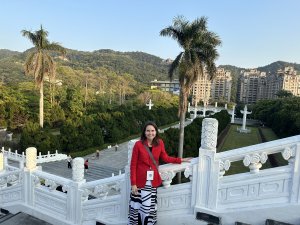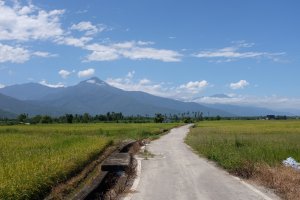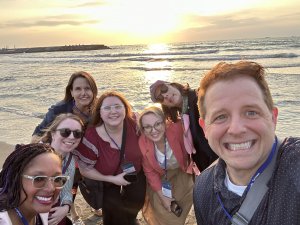My journey to the Fulbright IEA began in a meeting with some of the people in my International Office. A the time I was at Western Kentucky University (WKU), as the Associate Dean of my college. I dealt with all things having to do with off-campus travel, and in this meeting we discussed some international opportunities for faculty and students. One of the administrators present asked if I planned to apply for a Fulbright IEA. In all honesty I had not heard of the IEA program before that but in browsing, I could see that some of the countries seemed to align with what we were doing here at WKU. Moreover, some of the timetables for applications and visits seemed to work out. Because it was the closest deadline, I initially applied for an IEA in Germany, but was not accepted. Taiwan was my original first choice, so I re-wrote my application, applied, and was accepted.
In fact, the notification of acceptance came while I was in Cuba working to establish connections with a couple of universities there. Cuba’s internet WiFi infrastructure is not reliable, so I was in a park holding my phone at an angle trying to connect to WiFi when I received the e-mail from Fulbright Taiwan. At first I couldn’t believe it, and handed my phone to a colleague, saying “I think I just received a Fulbright award!” I sent a quick “I definitely accept,” and began to plan my trip.
My first step was to talk to as many faculty and students who had been to Taiwan as possible. WKU has a few faculty from Taiwan, and one who does extensive work there, but WKU did not have many connections to the country. This was both a source of excitement—I’d have a chance to open some new avenues for our college—and a bit of a problem for someone like me who likes to plan his adventures well in advance.
A week or so after the initial notification we discovered the names and institutional affiliations of our fellow travellers. I confess to having been somewhat puzzled at first—I was the only person with an academic appointment in our group. Everyone else, save one, worked in an centralized international office while I was the international program person for a single college. Despite feeling like maybe I did not quite belong, I was excited to meet a new group of colleagues and to learn as much from them as possible.
The flight over was a long one—I left Nashville, TN, at 6:30am on a Friday and arrived in Taipei at 9:00pm on Saturday. Some of us were on the last leg of the flight together, and we managed to say some quick hellos. After getting to the [wonderful!] Amba Hotel our group headed out for a quick meal and a drink. Our group was amazing. We were very lucky to have a cohort where everyone got along, and there simply wasn’t any drama. On different nights different people went out together, but no cliques formed and I felt like everyone was very comfortable with each other. The likability of the group members made our interactions with the Taiwanese faculty much smoother, and I think we all quickly got into a relaxed rhythm with our hosts that was made easier by our comfort with each other.
In all honesty, the first day or two was a blur. We quickly established a routine of waking up, eating breakfast, and heading out for visits. I was especially impressed by my time at National Chengchi University, with whom WKU already had an established partnership. The campus was beautiful, and the staff we were able to meet were friendly and ready to answer questions. As with other campuses they were eager to establish or expand partnerships, and it was clear from this short visit that I need to come back specifically to meet with these folks. That university is very much like our college in what it offers—social sciences, liberal arts, arts, humanities—but also has a range of other specific options.
I enjoyed each visit, but a few universities gave me a unique perspective on how to think about Taiwan. I was struck by the beauty of Wenzao Ursuline in Kaohsiung. I don’t know that my college would have necessarily needed a formal agreement with Wenzao, but it’s a place that I think someone at WKU would like to spend some time. Similarly Tunghai University in Taichung was a valuable stop for me. As with Wenzao the university itself is gorgeous, but I don’t know how much we would be able to support a formal agreement. Still, I quickly contacted one of my faculty members and specifically suggested she look into applying for a Fulbright there. Her work on religious ecology would fit perfectly with some of the things they’re doing there. And finally National Taiwan College of Performing Arts was an amazing visit with a wonderful performance. There’s very little for us there in terms of a need for an agreement, but I’ve spoken with our arts faculty and students already to get them thinking about the possibility of individual initiatives. The visit to National Taitung left me wishing I could work in the library there. More importantly, that location seemed idyllic—both for study and as a place for faculty to teach. The city itself was also an interesting change from both Taipei and Kaohsiung.
We had time to ourselves for the middle weekend of the Fulbright, and my hope was to travel and see something new. Initially, I thought I might fly to Ho Chi Minh City in Vietnam, but the timing was too difficult. That turned out to be a lucky break, and I instead took the rail to Kaohsiung on Friday night, and then spent Saturday walking around before heading back to Taipei on Sunday. My Saturday began with the Lotus Pond, and I took about three or four hours to walk around the loop. Along the way I wandered through a dozen temples, each seemingly more beautiful than the last. At the north end of the pond there was a street market with clothing, household goods, and a very large section devoted to seafood. Near the Confucius Temple I watched what appeared to be a photo shoot for a magazine, and I then completed the circuit and walked up a nearby hill to look at some old Japanese fortifications. I made my way to the Museum of Fine Arts before walking to the riverfront area for a small meal.
My time in Kaohsiung was very short, and it’s one of the reasons that I want to get back to Taiwan as quickly as possible. I met a lot of very nice people, and enjoyed my experience in the city. Many people told me how much different Kaohsiung is, culturally, socially, and politically, from the rest of Taiwan. I feel like I only got to see a small part of it.
One of the things that really excited me ahead of my visit to Taiwan was the chance I would have to try new food. When I travel I plan my time around visits to local eateries, and I am someone who revels in trying interesting local cuisine, especially things that Americans might consider strange. So, ahead of my arrival I mapped out a number of restaurants and, of course, all of the night markets I could find. I haunted internet discussion boards to get an idea of which night markets would be the “most local” in order to avoid the touristy places, and tried to find out what to look for and what to avoid.
I was not disappointed by the food in Taiwan. Upon our arrival on Saturday the five of us on the same flight walked up the street to find a bite to eat and have a chance to chat. Of course the Ximending Pedestrian had a number of restaurants, and street food was readily available. I happily scooped up some scallion cakes and quail eggs as we walked down the street. At the restaurant we had the famous Taiwan fried chicken and fried pork, along with two of the largest glasses of beer I have seen outside of Germany. On our first day, during orientation, Dr. Vocke gave us a strenuous warning not to dive right into the street food until our stomachs had had a chance to acclimate. Ah well.
On Sunday a group of us walked to the nearby Longshan Temple, which was stunningly beautiful. After making our way through the temple itself, and making a circle around the grounds, we headed for the Guangzhou night market. I was eager for some stinky tofu, but we did not have time for a stop, and the group was interested in getting to a restaurant for something a bit more formal. It was not until the 13th, at the Shinlin Market, that our group encountered the famous Taiwanese “delicacy.” We discussed how to find a stall selling it, but it turned out that we could simply follow our noses. At the Shinlin stall the stinky tofu was a bit softer, almost stir-fried instead of deep-fried. I layered some oil and sauce onto it and had my first bite. To be honest I was not quite prepared for the flavor. The aroma suggested something that would be very strong, and yet while the taste of the fermented curd was present, it was not overwhelming. I actually enjoyed it, and had the chance to try stinky tofu in several other places, including down in Kaohsiung. During my time in Taiwan I was able to try a number of interesting foods, including snake blood, pig blood cakes, some exotic fruits, and more seafood than I would have thought possible.
I was lucky enough to also be able to walk out to get street food for breakfast each morning. The fan tuan (a rice ball or vegetables and meat wrapped with sticky rice ball) and dumplings probably added a few inches to my beltline, but they were well worth it. More importantly than the odd dishes was the overall loveliness of every meal we had. There was always more food than we could eat—which made us feel a bit guilty—but I felt like we had the chance to experience “real Taiwan” at almost every meal. The food in Taiwan will leave a lasting impression on me.
I was grateful for the opportunity to meet with the Fulbright ETAs on our trip around the island. WKU promotes the Fulbright ETA quite heavily with its students, and so it was good to hear about their experiences. We met up with them at the National Pre-History Museum in Taitung and I think everyone in our group took the opportunity to latch on to a few people and to get an idea of what it was like to be an ETA in Taiwan. I know it will help me talk about it more competently with our students.
I’ve been trying to reflect on what I’ve learned during my Fulbright time in Taiwan. An easy answer is, of course, that I want to go back as soon as possible. More than that, though, I took some very specific lessons back to Western Kentucky University. At work, I’ve become more focused on how to make international travel more efficient in general. WKU has a number of agreements with universities, and an honest reflection is that we don’t have the capability or willpower to support all of them. My IEA Fulbright taught me that we need to sharpen our focus on a few universities and make them administratively more accessible to faculty and students. In Taiwan I can see that happening with WKU’s existing partner, while at the same time we can remain connected to other universities in a way that will keep options open for students and faculty.
I have also traveled to China, and made some visits there. While I value our connections in China, promoting student and faculty work in Taiwan has benefits that did not become apparent to me until my IEA Fulbright. First, English is nearly universal in Taiwan. Most US students who do not speak, read, or write Mandarin or Cantonese will nonetheless have many options for study at almost any school in Taiwan. Second, the educational atmosphere in Taiwan is unfailingly welcoming for foreigners in general and Americans in particular. Third, the Taiwanese culture is incredibly friendly and open, and I think our students and faculty will find a home more easily here than in almost any other place in the world. Fourth, one lesson from Taiwan is that we don’t necessarily need to have formal academic partnerships in order to promote exchanges. I have a number of faculty who I have already contacted to get them interested in applying for a Fulbright at a Taiwanese university—this doesn’t require formal agreements, but can certainly lead to bigger things. Finally, the small size of the country will give students and faculty the opportunity to explore it thoroughly in the space of a semester or a year, whereas they would not see very much of a larger country. My only worry about sending students and faculty to Taiwan for study would be in trying to get them to come back home to the United States.
My final lesson comes from the staff of the Fulbright Taiwan office. The Fulbright staff was incredible, and it simply would not have been possible for us to have had the experience we did without their careful planning, patience, and attention to detail. Charlie’s initial planning and preparations made the travel to Taiwan absolutely flawless. I have trouble imagining the amount of patience that Lisa Lin had to maintain in order to herd the butterflies that was our group. And Daphne’s week with us was a breath of fresh air. It speaks to Dr. Volke’s leadership that he has assembled such a talented crew. This was a life-changing experience for me, and my only regret is that I cannot do this again.
Managing Editor: Yu-Ping Chang 張瑜玶





